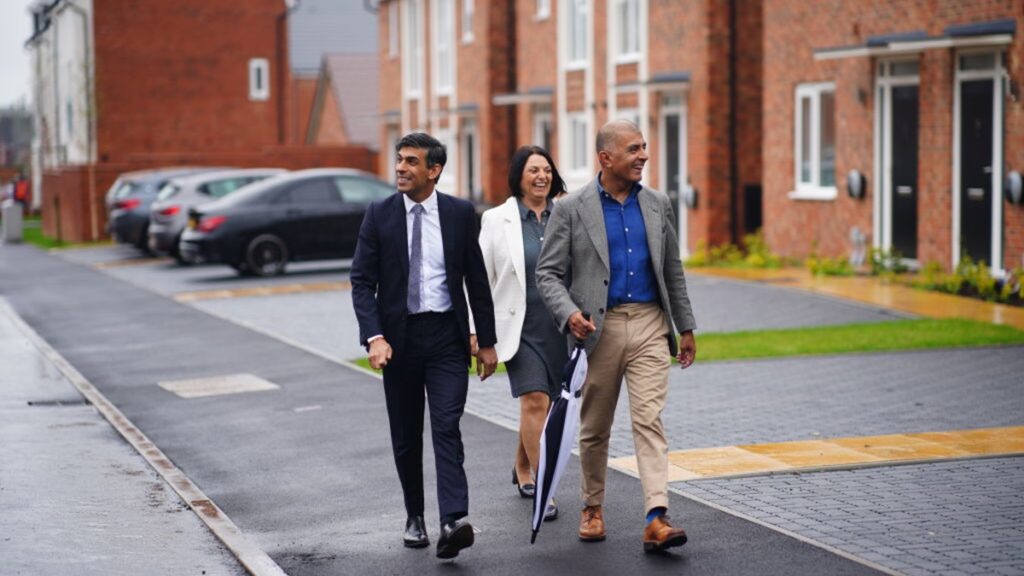Starmer is a man with a plan – for a huge expansion of housebuilding
Housebuilding is likely to be a key battleground at the next election as politicians attempt to balance the need for more homes with a 'not in my backyard' outlook from voters

What will be the biggest change if, as expected, Sir Keir Starmer wins the general election? For all their apparent differences, the approaches of Labour and the Tories are remarkably similar when it comes to the traditional electoral battlegrounds.
Both offer the same tax cuts, both warn of years of constraints on public spending to come and both will face the same seemingly intractable challenges as they attempt to bring down NHS waiting lists.
The point on which they diverge the most is on a policy usually deemed too unglamorous for the cut and thrust of an election campaign, but one that is of huge national importance: planning reform.
Starmer’s keynote speech at the Labour Party’s annual conference last September attempted to thrust the issue centre stage. Labour, he said, would “bulldoze” the planning restrictions that have held Britain back for generations. His party would “fight the blockers” as it sought to restore the dream of home ownership for millions of people.
The Labour leader has chosen to put the war on nimbies at the heart of his campaign. Nothing is off the table. The green belt, green fields, new towns, all are up for grabs as Starmer seeks to “get Britain building”.
Why housebuilding matters
There is political logic behind Starmer’s positioning. Labour’s psephologists have pored over the polling and established that the principle of backing housebuilding is popular. The vast majority of people are in favour of development when it is not in their backyards.
More specifically, it matters in the seats that Labour is targeting. Housing is the top issue in a quarter of the party’s 100 most winnable seats, particularly a swathe across Middle England that is likely to be pivotal to Labour’s chances of winning the election.
But Starmer’s decision to focus on planning is also one borne of necessity. If Starmer wins the election his fiscal room for manoeuvre will be severely constrained. The Tories are planning an Autumn Statement that is likely to include significant pre-election giveaways in the form of tax cuts.
The Office for Budget Responsibility, the fiscal watchdog, is pencilling in increases in public spending of just 1 per cent a year after 2025. When protected areas – the NHS and education – are removed from the equation it means significant cuts to other departments and what economists have warned will be a new era of austerity.
While both the Tories and Labour have signed up to these bleak – and some argue unrealistic – public spending profiles, neither party has spelled out where the axe would fall. Their political interests in this are perversely aligned. What party would be willing to go to the polls spelling out a programme of tax rises or spending cuts?
As we enter the final furlong before the general election is called, housebuilding and home ownership have never been more relevant
In the absence of financial firepower, supply-side measures such as planning reform have become critical to Starmer’s hopes of growing the economy. Put simply, Starmer needs to grow the economy without increasing public spending.
Starmer’s hopes of weaponising planning as an issue have been helped by the seemingly eternal psychodrama of the Conservative Party over the issue. The past 14 years have seen revolt after revolt, with the free-market aspirations of some Tory MPs coming up against the desire of others – particularly in southern England – to protect their constituents from what is seen as unnecessary development.
That tension has culminated in a series of mass rebellions. In December 2022, two months into his premiership, Sunak abandoned plans for mandatory housebuilding targets for local authorities, making them advisory instead. Planning experts warned that at the stroke of a pen the government had cut the number of homes likely to be built a year by as much as 77,000.
At the end of last year, the government went further, announcing that councils will no longer be forced to set aside greenfield land to meet future housing need. Councils were also given an exemption from building new homes on prime agricultural land.
Missed housebuilding targets
Experts say that the government appears to be on course to miss its own target for housebuilding. When Boris Johnson won the general election in 2019, he recommitted to an annual target of 300,000 homes a year “by the mid-2020s”.
To date, the government has consistently fallen short. In 2019-20 there were 248,591 “net additional dwellings”, a figure which fell to 217,754 in 2020-21 in part because of the pandemic. In both 2021-22 and 2022-23 the figure was fewer than 235,000 homes a year.

The prime minister has pledged to “protect” green spaces and instead said new houses will be built in “great cities” rather than “concreting over the countryside”. But senior Conservatives are privately – and in some cases publicly – lobbying him to take a more forthright approach.
Amid the Tory climbdowns and divisions, Starmer has spied an opportunity. The Labour leader has pledged to build 1.5 million homes over the course of the next parliament, primarily by reinstating the very mandatory housebuilding targets that the Tories are preparing to scrap.
He also announced plans to build a string of new towns and said that Labour would be willing to build on low-quality areas of the green belt, which he described as “grey belt”. The Tories responded by pointing out that 233,000 homes a year have been built under successive Conservative governments on average, compared to 170,000 under Labour. They have also announced plans to build more on brownfield sites in cities and the government recently said that it wants to “turbo-charge” development in Cambridge, with up to 250,000 homes built in the next 20 years.
The Tories are also preparing their own offer on home ownership although, unsurprisingly given the party’s internal divisions, it is unlikely to focus on planning.
Instead, the Tories want to focus on cutting the cost of home ownership for first-time buyers in a bid to appeal to younger voters. A variety of options are under consideration, including much longer fixed-term mortgages that reduce the amount of money that is needed for a deposit. Stamp duty reductions are also on the table.
As we enter the final furlong before the general election is called, housebuilding and home ownership have never been more relevant. For generation rent, it could prove to be a truly significant moment whoever wins.
Steven Swinford is the political editor of The Times.


